2021 Hyundai Kona Electric review
Hyundai’s been an electric car trailblazer in Australia, and its Kona Electric small SUV has proved one of the best all-rounders in terms of size, range, tech and (just about) affordability.
Launched in 2019 with impressive 449km range (perfectly achievable, too), this year it has received styling, safety, and infotainment enhancements, plus a range boost to a mighty 484km.
The Kona Electric range consists of Elite and flagship Highlander. Since August, Hyundai has made both available in Standard Range (39.2kWh battery) and Extended Range (64kWh battery) guises, the former a more affordable and lighter version offering an EV range of 305km.
While the Kona Electric has earned its stripes in Australia, it now faces a massive challenge from within.
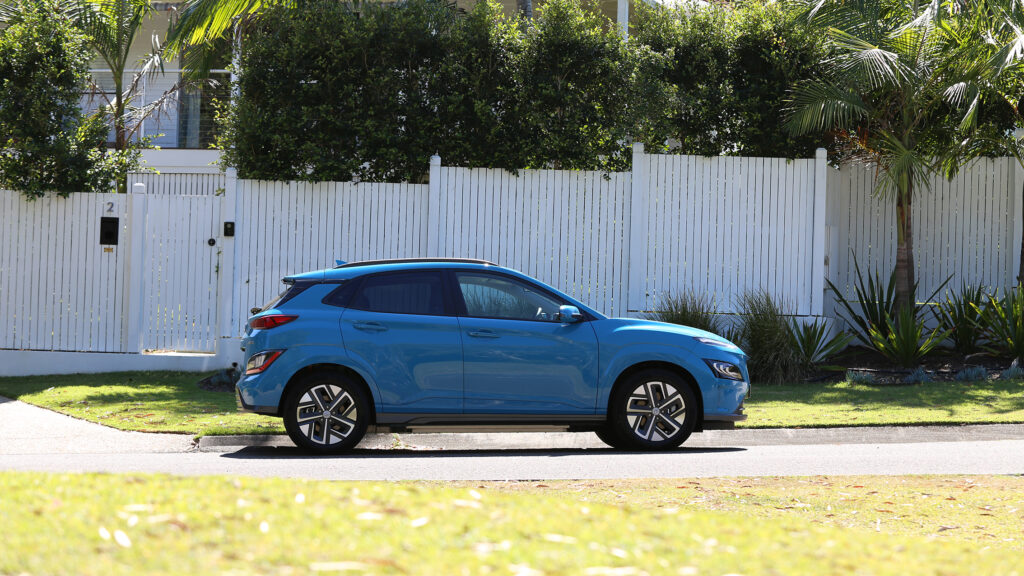
Hyundai’s eagerly-anticipated Ioniq 5 is just about to hit showrooms priced from $71,900. This new kid was engineered from the outset to be electric-only; the Kona was developed to harbour a combustion engine or be an EV. Inevitably, the Ioniq 5 will be the smarter and better packaged EV.
The Kona Electric does have one key edge: availability. Queues for the Ioniq 5 are set to be down the street and around the corner for quite some time, so is the Kona Electric worth considering?
Value
Prices start at $54,500 plus-on roads for a Kona Electric Elite Standard Range. The higher-spec Highlander version is $58,000 plus charges, while Extended Range versions of each are $60,500 and $64,000 respectively, before charges.
Depending on where you live, drive-away prices could be reduced by up to $5000 courtesy of incentives and rebates from state governments.
Extended Range Konas aren’t a million miles off the Hyundai Ioniq 5’s sticker price, not helping the less-in-vogue Kona’s case.
Chief rival in the circa $60k playground is the Tesla Model 3 Standard Range Plus, Australia’s runaway best-selling EV.

Unless you’re feverishly anti-Tesla or will settle for nothing but an SUV, you should cross-shop the impressive Model 3 against a Kona Electric. The Tesla certainly feels more Brave New World, if that’s your bag.
All Kona Electrics get 17-inch alloy wheels, smart key entry, leather trim, digital dashboard, wireless phone charging, a Harman Kardon sound system, 10.25-inch central screen with Apple CarPlay and Android Auto, rear camera and rear park assist.
The Highlander adds goodies like LED lights, glass sunroof, power and ventilated front seats, heated steering wheel, heated rear seats, ambient lighting, head-up display and front park assist.
Inside
Hop inside the Kona Electric and it’s all very familiar. If you want your transition to electric vehicles to be as easy as possible, the cabin looks and feels very much like a petrol-engined Hyundai.
That’s good and bad.
Good in that there’s very little learning to do. Okay, your gear shifter is replaced by buttons marked P, D, R and N, but your general infotainment, climate, switchgear and controls are as-you-were.

By contrast, hop in the Tesla Model 3 and you’re faced with a spartan dashboard and everything controlled through a giant iPad-type screen.
The not so good is that there’s not much in the Kona Electric to make you feel special. Door top and dash top plastics are too hard for a car that can cost $70k on the road, while rear air vents are missing.
The leather seats do feel of high quality however, and as with most modern Hyundais, build quality and finish – cheaper plastics aside – are excellent. Optioning the Black/Grey leather trim seems wise as it brings lightness – the full black feels too dour.
Rear seats remind this is a small SUV. Adults will find the knee and toe room a bit restrictive although head room and seat comfort are good. But three adults across the back row proves very cosy.

If you have younger kids the rear space is fine, and they’ll appreciate the Highlander’s rear heated chairs on cold mornings. No rear vents will have them grumbling on hot days, and a solitary USB point for the back row could cause Millennial bust-ups.
Its 332L boot – a good deal less than a Volkswagen Golf hatchback for example – also highlights the Kona Electric is better suited to empty nesters rather than families.
Performance and efficiency
It’s surprisingly rapid. The Kona’s single permanent magnet synchronous motor produces 395Nm – a solid amount of torque that arrives instantly, driving the front wheels.
Power-wise, Standard Range versions get 100kW and Extended Range 150kW. We haven’t yet tested the 100kW version, but an identical torque figure suggests the Kona’s zippiness will be similar.
The front tyres get a bit overwhelmed when you floor the throttle. It was a bigger issue in the pre-facelift Kona Electric on its Nexen Eco tyres, where wheelspin happened with even a mild prod of the throttle, especially in the wet.
You get less ‘Who’s this hoon?’ stares in the new version thanks to Michelin Primacy 4 low rolling resistance tyres. Showing the massive difference rubber can make, these tyres have been the main factor in the Extended Range’s range climbing from from 449km to 484km – a 7.8 percent improvement.
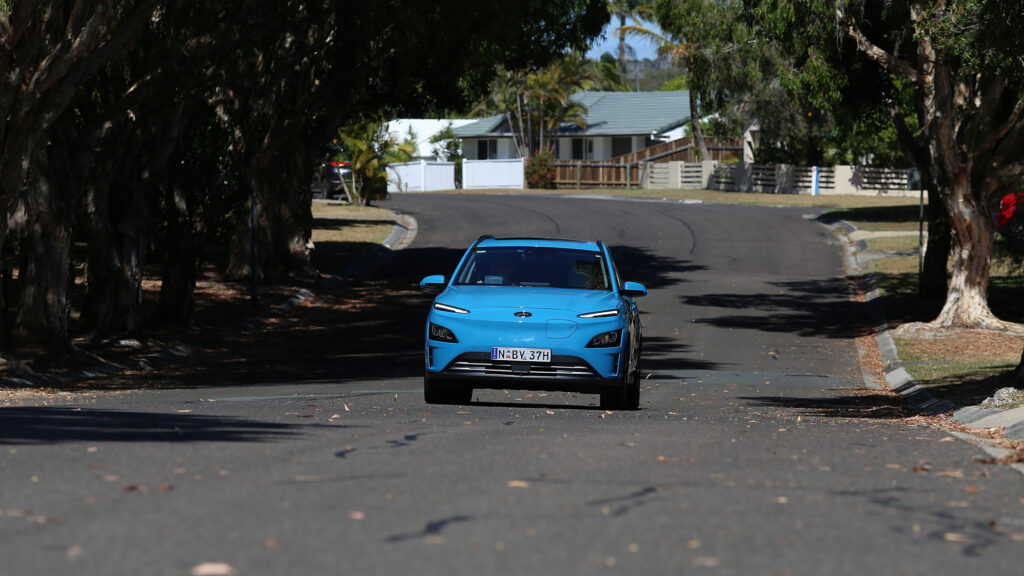
Our test found the near-500km range claim to be wholly achievable. The on-board range computer’s predictions were highly accurate – as we’ve previously found with the truth-telling Konas – and with your sensible hat on, that’s range enough for every conceivable use.
Planning 1000km in a day? Hopefully you’ll factor in an hour-long stop for a feed and some rest, and in that time a fast charger will get that battery back to near full.
Hyundai’s quoted energy consumption is 14.7kWh/100km (14.3kWh the Standard Range) by the WLTP method. We bettered that with a 13.1kWh/100km average.
Shorter around-town trips (the busy school run, mainly) returned figures of 12.4kWh/100km, 12.1kWh/100km, 11.1kWh/100km and even a 9.8kWh/100km. A higher speed (110km/h) motorway commute returned just over 13kWh/100km. Very impressive.
Charging
Such impressive and reliable range means if the Kona’s your daily runaround, you really don’t need to charge it very often.
With school runs, shopping and a few errands, our weekly use barely goes over 350km. As long as we don’t do a long trip away, theoretically we’d only need charge it once a week.
It was easiest to give it a bit of boost overnight in the garage. As an example, just using a domestic socket, our Kona Extended Range had 33% or 162km range remaining. I plugged it in and it said it’d take 25 hours to reach 100% charge with the 2.2kW rate.

Twelve hours later (7pm – 7am) it showed 66 percent charge and a range of 320km. Ample for urban duties.
Hyundai’s home wallbox charger is $1950, and that gives empty to 100 percent charge in just 9.5 hours (Extended Range) and 6.5 hours (Standard Range), and would be on my shopping list if I owned the car. Or you can buy any Type 2 wallbox.
While AC maximum charging speeds are the same (7.2kW) for the Standard and Extended Range, DC charging – using a CCS Combo plug – is halved from the Extended Range’s 100kW down to 50kW for the Standard Range.
Count on 47 minutes for a 50kW charger to have the latter go from 10-80 percent, and the same time for a 100kW charger to do 10-80% in the former.
The battery has an eight-year, 160,000km warranty and guarantees at least 70 percent of its original capacity will be in place.
Ride and handling
For its size, the Kona Electric is a very well-rounded offering. The new Michelins feel slightly better at absorbing bumps and reducing road noise than before, making for reasonably cosseting cabin comfort.
At highway speeds and radio off you’ll suffer audible tyre noise, but make best use of the Harman Kardon sound system – which is excellent – and you’ll not be troubled.
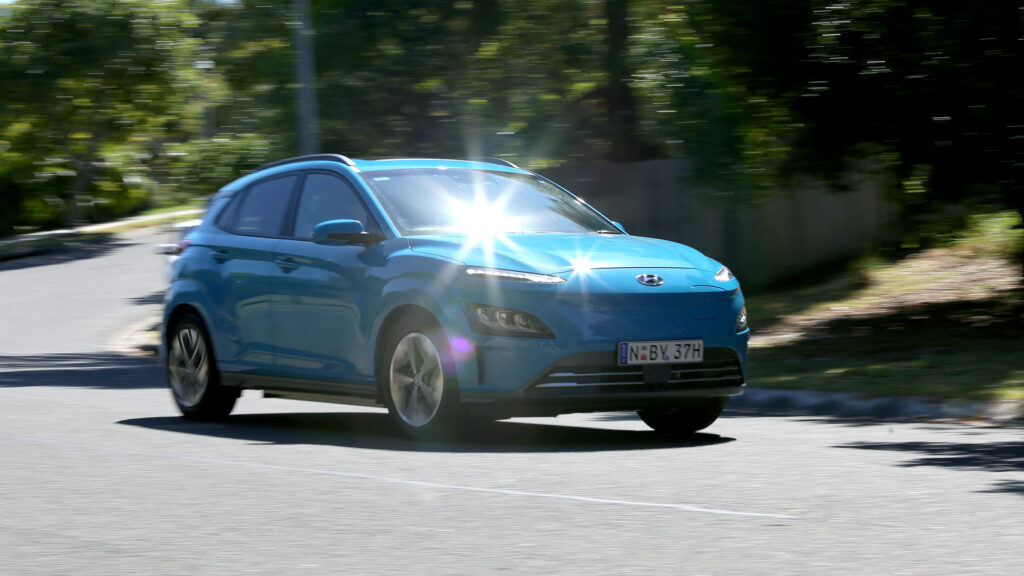
Around town and from standstill it’s zippy, playful and quite good fun too. The electric motor makes a subtle spaceship sound, and in Sport mode with a hard right foot, once the tyres scrabble around for grip you build speed at a grin-inducing rate. It won’t pin you to your seat, but you’ll want to show off the acceleration fun to your mates.
Cornering at speed feels safe, controlled and balanced, but the sheer weight of this little EV robs it of true sporty feel. Steering, too, is too light and numb to offer much joy, but only very few will be tackling fun twisties that often.
There are three levels of regenerative braking, and even set to maximum it’s not too aggressive. If you really want to drive a ‘normal’ feeling car, switch it off completely and do your braking as per usual.
We found the Level 3 setting was ideal for city driving. It soon became second nature to perfectly time the lift-off and let the car slow itself, that brake pedal barely needing a touch.
Party tricks
Aside from the Look At Me ‘Dive In Jeju’ blue paint of our test car (as seen in the pictures), the Kona Electric is able to come to a complete stop using regenerative braking.
When approaching a junction, lights or stopped traffic, you pull a steering wheel paddle and the car comes to a halt.
This means total feet-free braking if you time it right – something many EVs (mystifyingly) don’t offer.
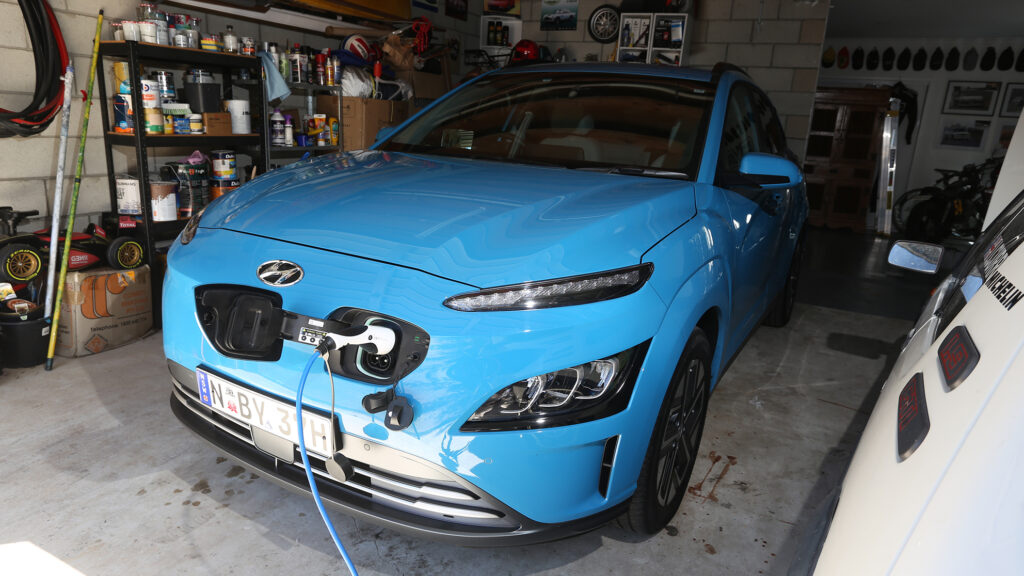
Safety
All Konas feature Hyundai’s SmartSense package as standard, and score 5 star ANCAP crash ratings.
This includes Blind-Spot Collision-Avoidance Assist (BCA), Driver Attention Warning (DAW), Forward Collision-Avoidance Assist (FCA), Lane Keeping Assist (LKA), Rear Cross-Traffic Collision-Avoidance Assist (RCCA), Rear Occupant Alert (ROA), Safe Exit Warning (SEW) and Smart Cruise Control with Stop & Go.
The lane keep assist can get a dash nannying and beepy, but it’s simply turned off via a steering wheel button should it start to annoy.
Verdict
The 2021 Kona Electric’s extra range and enhanced equipment boost an already impressive offering.
It’s an expensive Kona (up to twice the price of a petrol-powered variant) but decent value for an EV with such range. For many, the $6000 cheaper Standard Range will have ample range, especially if it’s mainly a town car.
Small SUVs are hugely popular so the Hyundai’s size is right; you needn’t suffer range anxiety, included kit is strong and the drive is well-rounded.
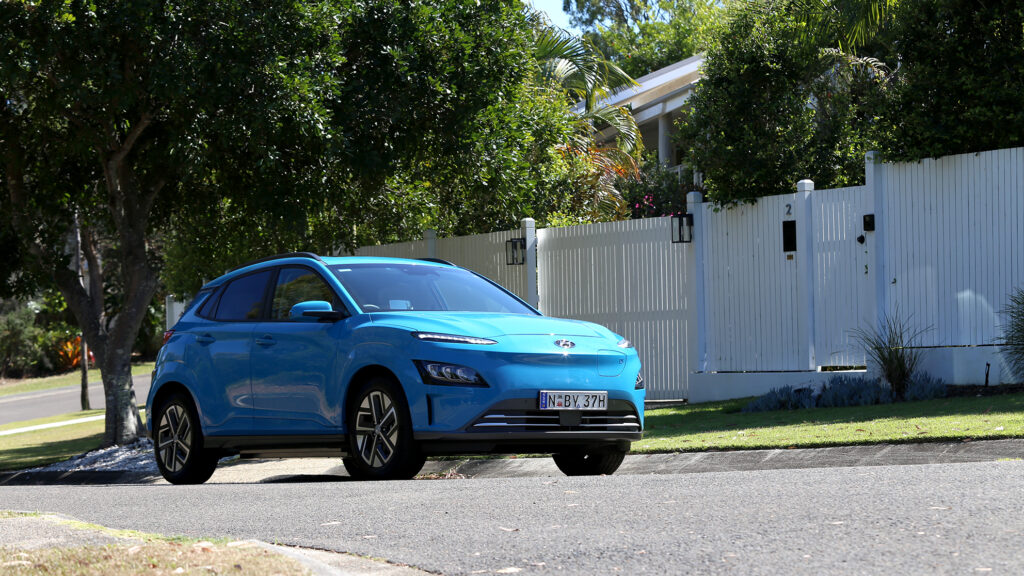
It’s a pretty ideal first dip into EV life for those considering it. There’s little to fear in the transition from petrol/diesel to electric with the Kona.
But like a king about to be slain by the throne’s heir apparent, the Kona Electric looks doomed with the Hyundai Ioniq 5 about to strike it down across the board.
That said, you can put your money down and drive a Kona EV away tomorrow. The Ioniq 5? Join what could be a long queue.
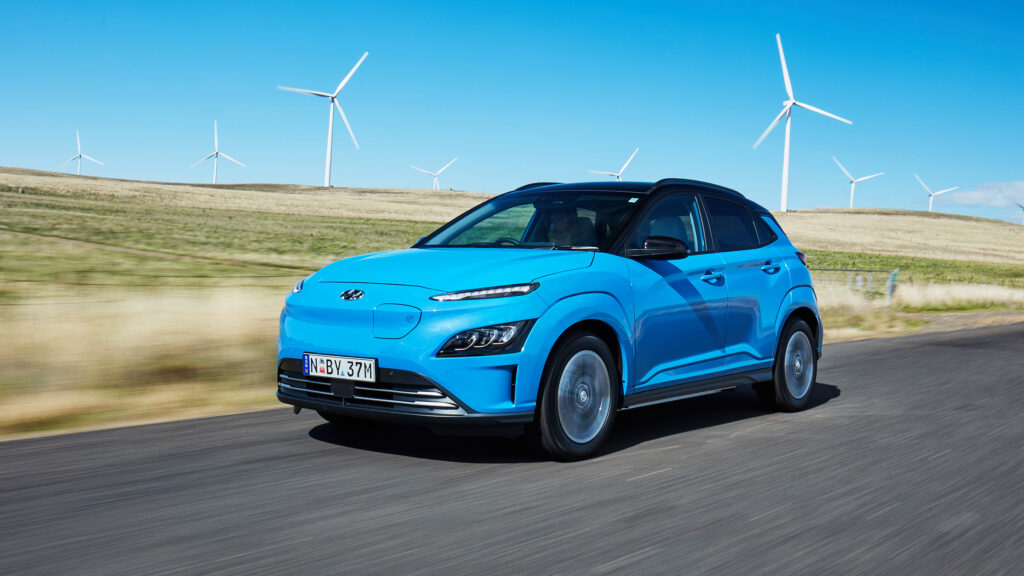
2021 Hyundai Kona Electric price and specifications
Hyundai Kona Electric Elite Standard Range
Price: $54,500, plus on-road costs
Basics: EV, 5 seats, 5 doors, compact SUV, FWD
Battery capacity: 39.2kWh
EV range: 305km (WLTP)
Energy consumption: 14.3kWh/100km (WLTP)
Motors: Single front, 100kW/395Nm
AC charging: 7.2kW, Type 2
DC charging: 50kW, Type 2 CCS
Hyundai Kona Electric Highlander Standard Range
Price: $58,000, plus on-road costs
Basics: EV, 5 seats, 5 doors, compact SUV, FWD
Battery capacity: 39.2kWh
EV range: 305km (WLTP)
Energy consumption: 14.3kWh/100k (WLTP)
Motors: Single front, 100kW/395Nm
AC charging: 7.2kW, Type 2
DC charging: 50kW, Type 2 CCS
Hyundai Kona Electric Elite Extended Range
Price: $60,500, plus on-road costs
Basics: EV, 5 seats, 5 doors, compact SUV, FWD
Battery capacity: 64kWh
EV range: 484km (WLTP)
Energy consumption: 14.7kWh/100km (WLTP)
Motors: Single front, 150kW/395Nm
AC charging: 7.2kW, Type 2
DC charging: 100kW, Type 2 CCS
Hyundai Kona Electric Highlander Extended Range
Price: $64,000, plus on-road costs
Basics: EV, 5 seats, 5 doors, compact SUV, FWD
Battery capacity: 64kWh
EV range: 484km (WLTP)
Energy consumption: 14.7kWh/100km (WLTP)
Motors: Single front, 150kW/395Nm
AC charging: 7.2kW, Type 2
DC charging: 100kW, Type 2 CCS

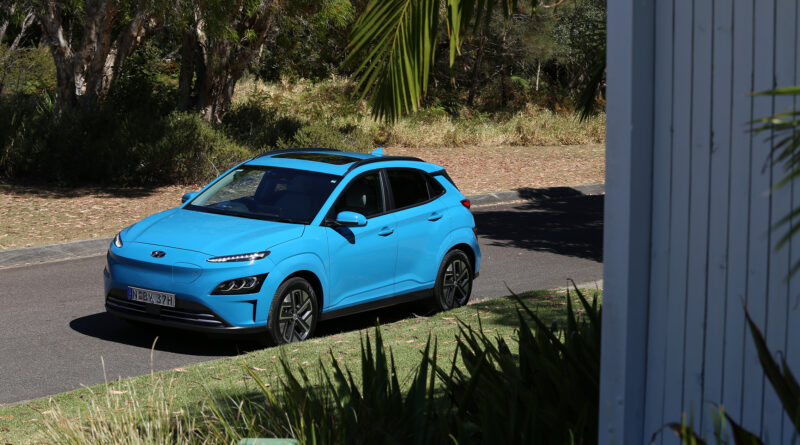

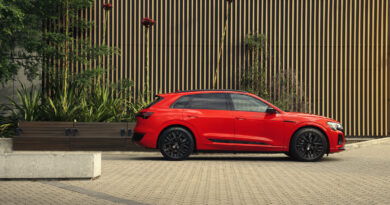
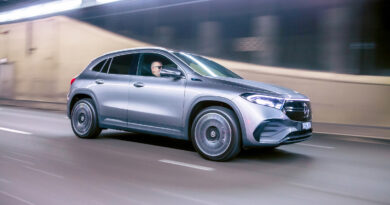
Good review, similar to one earlier in the year. Perhaps that explains why you didn’t mention the Nissan Leaf e+ as competition. Similar range and price. I’ve driven both, and these two are top of my list for my next car.